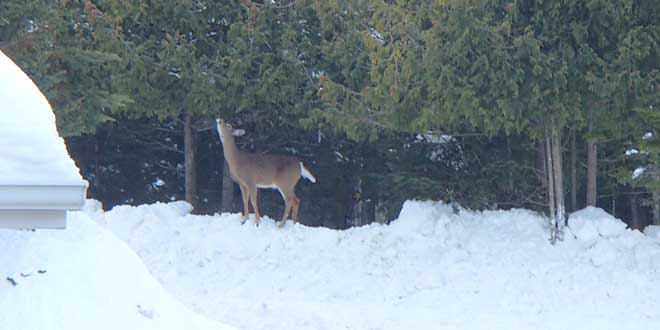MANITOULIN—While many landowners and volunteers have stepped up to do their part for Manitoulin’s deer population, the harsh winter is catching up with the herd and the weakest are starting to die from malnourishment.
Ian Anderson, a member of the Manitoulin Area Stewardship Council (MASC) and deer management committee, explained that in the area of his Kagawong home over the course of the last two weeks, he has seen two dead fawns, one dead yearling and one fawn within a day of dying—the result of a record-cold and snowy winter on Manitoulin Island.
“This is too early to be losing deer like this,” Mr. Anderson said. “This is the earliest I have seen it since I’ve been on Manitoulin.”
Thanks to donations rolling into the MASC-sponsored deer save program from concerned citizens and the Little Current and United Fish and Game Clubs, a bulldozer, manned by Aaron Corbiere of Corbiere Enterprises, was currently at work in Kagawong, breaking trails for the deer.
“Right now we’re using the bulldozer in the Kagawong area on five different 100 acre lots,” he explained, adding that not more than three hours is spent on any one property so as to get to as many trails as possible. “As money permits, the bulldozer will be on the move.”
Mr. Anderson was effusive in his praise for Mr. Corbiere, who has been generous with his rate and has thrown in his travel with the dozer as his own personal donation.
Mr. Anderson said it is heartening to see deer tracks on the bulldozer tracks immediately following the trails being opened. The blade on the bulldozer, he explained, isn’t lowered right to the ground so as not to disturb the land.
“We’re trying really hard to create no disturbance and to use existing trail systems if at all possible,” he added.
Different areas of the Island are reporting varying states of distress with the herd, Mr. Anderson said, noting that the snowfall patterns on the Island also differ, and this is likely related to the state of the individual herds. Many in Billings and Allan report seeing the telltale sign of a deer in distress—a big fuzzy face indicative of malnourishment—whereas Bidwell farmers are reporting unhealthy looking, but surviving, deer.
Donations to the deer save program cover the cost of running the bulldozer and also the fuel for the volunteers with snowmobiles who break trails on participating landowners’ properties.
“This is essentially what we have been predicting since early February,” Mr. Anderson said of the deer mortality. “This is the worst winter since 1995-1996, if not longer. With the passing of every night when it’s below zero, it just adds to the severe winter index (which judges the animals’ chances of survival). And the long range forecast is not good—March is predicted to be seven degrees colder than average each night.”
Mr. Anderson explained that this is the time of year, when the days become longer, when the deer’s metabolism naturally picks up, meaning their nutritional requirements increase too.
“It becomes critical for a quick breakup and greenup, but I don’t think that’s going to happen by April,” he added.
He said that while he has seen some dead deer, there will be the deaths that are unseen, such as the unborn fawns and the yearlings, but it won’t be until the fall hunt that the impact will be obvious.
“I would be shocked if the number of antlerless tags doesn’t go down this year,” he said, explaining that this decision will be made by the MNR later this spring.
Sue Meert, the Manitoulin deer save coordinator, said she is pleased with the numbers of landowners and volunteers who have come forward but said they are still looking for more. Currently, almost 60 landowners have signed consent forms for the 24 volunteers to break trails and cut browse on their properties. Another 25 landowners are doing this themselves, bringing the total acreage to over 4,000.
“I’ve been doing a lot of educating too,” she said, noting that she has fielded more than one phone call from people wanting to get involved, saying ‘I’m going to buy a couple of bags of corn.’ “I tell them ‘no!’ and encourage them to visit the MASC website and watch the ‘how to feed deer video,’ which has been incredibly helpful.”
“I’m hearing from a lot of people that they’re seeing the deer, seeing them malnourished and have a lot of concern,” Ms. Meert said. “I’m hoping we’ve made an impact. We are expecting losses, but what we’ve done will help.”
To contact Ms. Meert, email her at manitoulindeersave@gmail.com or phone her at 705-859-1187. To watch the deer feeding video, visit the MASC website at www.manitoulinsteward.org or to donate to the deer save program, contact the Central Manitoulin municipal office at 705-377-5726 and ask how to donate to that account.




